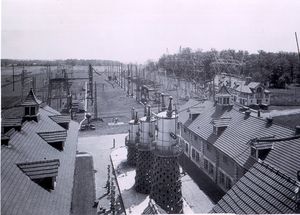Ohio Brass High Voltage Laboratories
Ohio Brass High Voltage Laboratories
Laboratory Number One -- 1910 to 1926
The first laboratory was located in Building 3 at the Ohio Insulator Plant at Park & 9th Streets in Barberton, Ohio. The principle test voltages used at this time were generated by Tesla coils with a frequency from 20 kilohertz to 70 kilohertz because the exact wave shape of lightning was unknown.
Laboratory Number Two -- 1927 to 1933
O. C. Barber, who had made his fortune manufacturing matches, and for whom the town of Barberton was named, died in 1920, but it took until 1926 to settle his estate. In 1926, Arthur Oswin Austin purchased a large tract of land, the mansion, and the horse barn belonging to the estate. The Ohio Insulator Company at about this time (1926-1928) had ordered four 2200 volt to 600 kilovolt 60 hertz test transformers from the Allis-Chalmers company. A. O. Austin found he could over excite the iron cores of the transformers to obtain a new rated average of 2750 volts to 750 kilovolts. A. O. Austin began testing with high-voltage impulse waves generated by charging a large screen wire conductor with the transformer bank and discharging it onto the test specimen. Figure 30 of A. O. Austin's paper entitled "A Laboratory for Making Lightning" presented in Paris, France on 6 June 1929 shows the fourth transformer installed in the Building 3 indoor test lab at the Ohio Insulator plant in Barberton, Ohio. A. O. Austin states that test voltages up to 900 kv were generated.
Laboratory Number Three -- 1934 to 1968
A. O. Austin retired in 1933, and the lower two transformers at the horse barn were moved to the new outdoor high voltage laboratory being constructed adjacent to the Ohio Brass factory in Barberton, Ohio. The indoor transformer could be connected in series with the two outdoor transformers by means of a high-voltage roof bushing. A September 1934 AIEE paper in Electrical Engineering, "A New Laboratory for High Voltage Testing" by J. T. Lusignan and H. L. Rorden describes the new outdoor and indoor laboratories at this site. A new 3000 kv MARX impulse generator was constructed for use in both the indoor and outdoor lab. In about 1960, a new outdoor 4000 kv impulse generator was constructed and many improvements were made. In 1967, high voltage design tests were performed for a proposed 765 kv transmission system for American Electric Power.
Laboratory Number Four -- 1968 to Present
The new outdoor testing laboratory at the F. B. Black Research Center opened in the summer of 1968. The high-voltage bushings on the three transformers were replaced with modern Ohio Brass condenser bushings. The insulated pedestals on which these transformers were mounted consisted of porcelain station post insulators. The 4000 kv impulse generator in Barberton was moved to the new lab in Wadsworth, Ohio, and a new 1000 kv addition was made.
The IEEE History Center gratefully acknowledges the materials and assistance given by John F. Wiitibschlager, High Voltage Lab Manager 1963-1993, in writing this article
